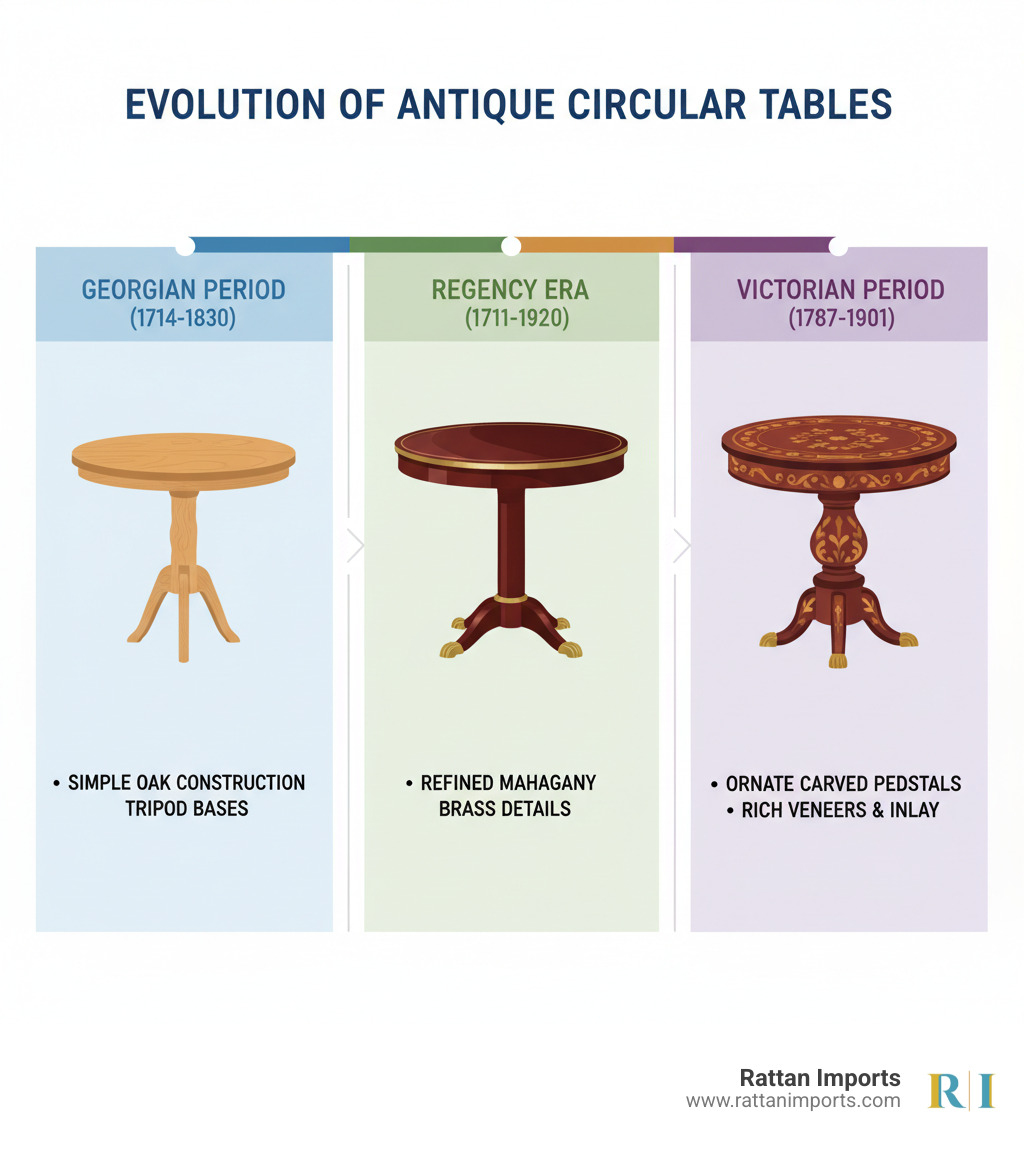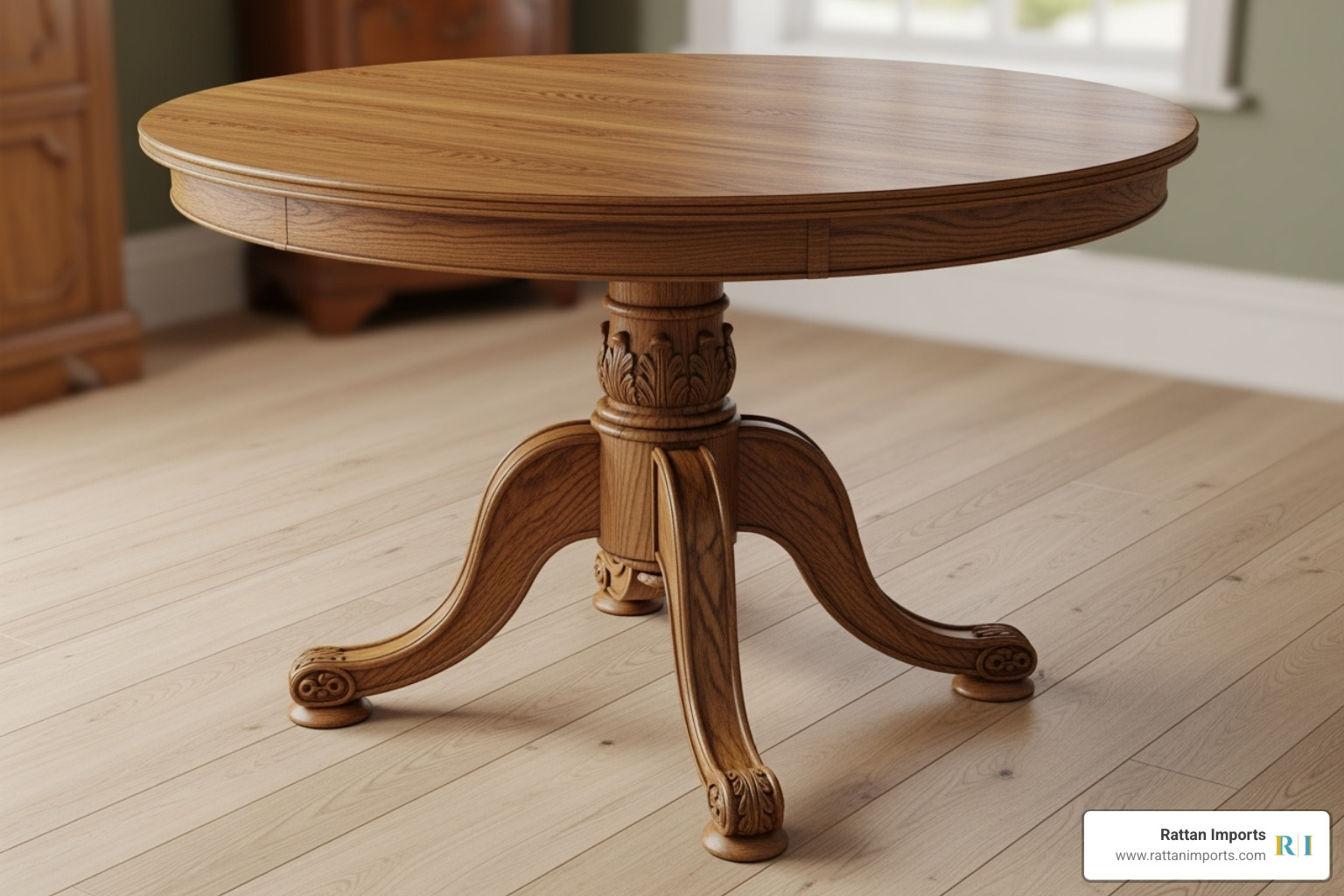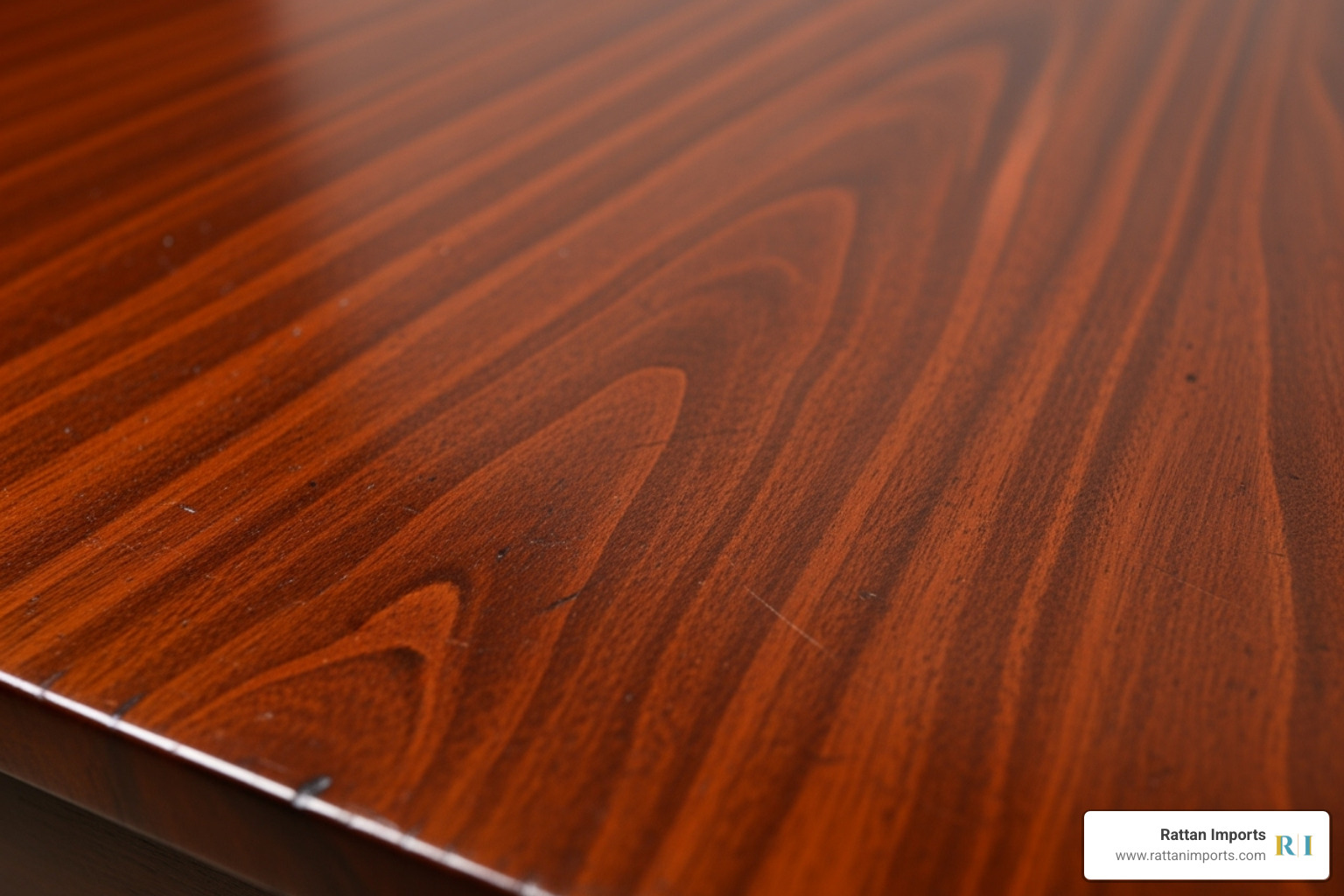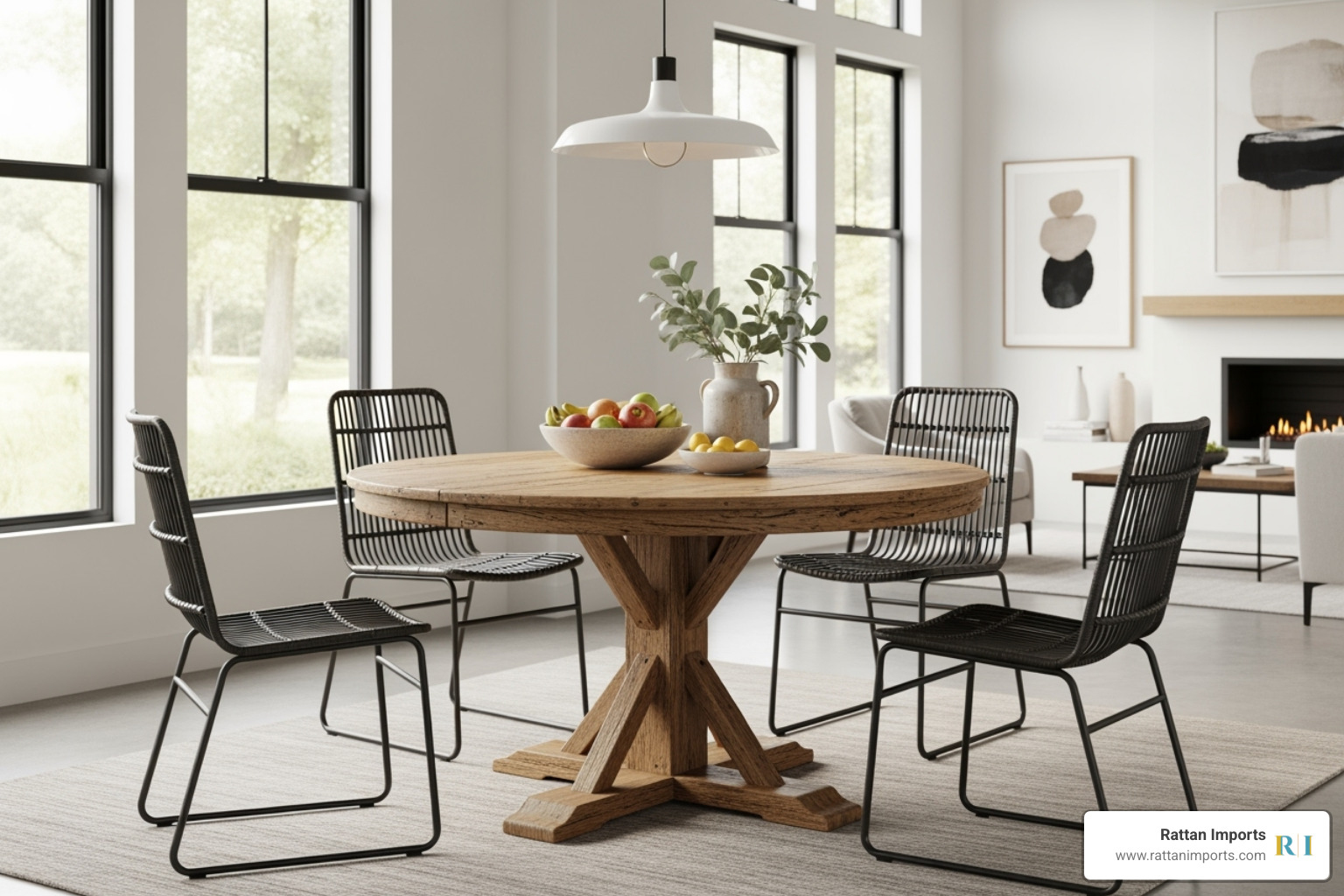Finding the Timeless Appeal of Circular Dining Tables
An antique circular table brings centuries of craftsmanship and character to any dining space. These round treasures offer both historical significance and practical benefits that modern furniture often lacks.
Key Features of Antique Circular Tables:
- Historical periods: Georgian (early 1700s), Victorian (1837-1901), Edwardian
- Common materials: Oak, mahogany, rosewood, walnut, pine
- Popular styles: Pedestal bases, tripod legs, tilt-top mechanisms, drop-leaf designs
- Typical uses: Dining tables, occasional tables, lamp tables, breakfast tables
- Price range: £80 to over £100,000 depending on period, condition, and provenance
- Benefits: Conversation-friendly shape, space-efficient, timeless design
The earliest form of antique circular tables dates back to King Arthur's Round Table in the 15th century. During the early Georgian period, round tables were first made on a larger scale, typically crafted from oak or other locally sourced timbers. The Victorian era introduced richer materials like mahogany, rosewood, and figured walnut, often featuring fine inlay work and carved decorations.
These tables have earned their reputation as the most well-used form of table throughout history due to their practical design. Their circular shape eliminates sharp corners, making them perfect for both intimate dinners and larger gatherings where conversation flows naturally around the table.
Whether you're searching for a statement piece for your dining room or a charming accent table for a hallway, understanding the history, materials, and craftsmanship of these pieces will help you make an informed purchase. From Georgian simplicity to Victorian opulence, each period offers distinct characteristics that can complement both traditional and contemporary interiors.
I'm Nino Russo Alesi, and my Italian heritage has given me a deep appreciation for craftsmanship and the art of creating beautiful spaces where families gather. Through my work at Rattan Imports, I've helped countless clients find the perfect antique circular table to anchor their dining spaces and create those precious moments around the table.

The Storied Past of the Circular Table
Every antique circular table tells a story that begins centuries ago, when craftsmen first understood something magical about the round shape. Unlike their rectangular cousins, circular tables have always been about bringing people together - no head of the table, no hierarchy, just equals sharing a meal or conversation.
The most famous circular table in history? King Arthur's legendary Round Table from the 15th century. While we can't be sure Arthur himself ever existed, the symbolism is powerful. That mythical table represented unity and equality among knights, with no single person commanding the "head" position. This idea of the round table as a democratic gathering place has echoed through history ever since.
But beyond legend, the circular shape simply makes sense. Antique circular tables became the most well-used form of table throughout history because they work so beautifully in real life. Everyone can see and talk to everyone else easily. There are no sharp corners to bump into, and the natural flow around a circle creates a warmth that rectangular tables struggle to match.
As social customs changed and craftsmanship evolved, so did these remarkable pieces. Each era left its fingerprint on the design, from simple country oak to elaborate Victorian masterpieces inlaid with exotic woods.

From Georgian Simplicity to Regency Refinement
The early Georgian period in the first half of the 18th century changed everything for antique circular tables. For the first time, these weren't just custom pieces for wealthy families - they were being made on a larger scale for ordinary homes too.
Georgian craftsmen worked with what they had nearby: sturdy oak and other local timbers that could handle daily family life. These weren't fancy showpieces - they were built to work hard. Many featured tilting tops that let you fold the table up against the wall when you needed floor space. Brilliant design for smaller homes!
The typical Georgian circular table stood on a central turned pedestal with three splayed legs ending in simple pad feet. No fuss, no frills - just honest construction that lasted for centuries. These tables did double duty as writing surfaces, candle stands, or wherever you needed a sturdy round surface.
As the Regency period arrived (around 1811-1820), you could see tastes starting to shift. Craftsmen began choosing finer materials and paying more attention to neat details. Mahogany started appearing more often, though oak remained popular. The basic design stayed practical, but there was a growing appreciation for beauty alongside function.
These Regency pieces became the perfect bridge between Georgian simplicity and the elaborate Victorian style that was coming. You can see the transition happening - still practical and sturdy, but with hints of the decorative flourishes that would soon define the next era.
The Ornate Elegance of the Victorian Era
When Queen Victoria took the throne in 1837, antique circular tables got a complete makeover. The Victorian era brought prosperity, and families wanted their furniture to show it. Simple oak gave way to exotic richer timbers that spoke of wealth and worldly sophistication.
Mahogany, rosewood, and figured walnut became the woods of choice. Craftsmen finded they could create stunning effects with flamed mahogany segments, carefully arranged to make tabletops that looked almost like kaleidoscopes. The natural patterns in these expensive woods became art in themselves.
Victorian tables weren't just about beautiful wood - they were canvases for incredible fine inlay work and carved decorations. Pedestal bases grew elaborate, with intricate turning and carving that showed off the craftsman's skill. Every surface became an opportunity for decoration.
The Victorians even created specialized tables for their favorite pastimes. Loo tables were designed specifically for playing the card game "loo," though families quickly finded they worked perfectly for serving tea or as general side tables. These featured the heavily carved, ornate bases that became a Victorian signature.
Whether displaying exotic inlays or supporting elaborate carved pedestals, Victorian antique circular tables made powerful statements about taste and status. They were the centerpieces of domestic life - equally at home hosting grand dinner parties or intimate family gatherings. Each one was a masterpiece of craftsmanship that still takes your breath away today.
A Guide to Finding Your Perfect Antique Circular Table
Finding your ideal antique circular table is like treasure hunting – you're not just buying furniture, you're bringing home a piece of history with its own unique story. The excitement lies in finding that perfect piece that speaks to you, but making a smart purchase requires understanding what you're looking at.
Every antique circular table has tales to tell through its wood grain, its gentle wear patterns, and the craftsmanship techniques used to create it. Whether you're drawn to the robust simplicity of a Georgian oak piece or the ornate elegance of a Victorian mahogany table, knowing what to look for will help you make a choice you'll love for years to come.

Identifying Types and Materials
The world of antique circular tables offers wonderful variety, with each type designed for specific purposes and lifestyles. Dining tables are the showstoppers – typically larger pieces meant to gather family and friends around. These range from intimate breakfast tables perfect for morning coffee to grand extendable versions that can host holiday feasts.
For more versatile options, occasional tables work beautifully in living rooms or hallways, providing the perfect spot for lamps, books, or that cup of tea you're always setting down somewhere. Coffee tables have an interesting story – many are actually repurposed antique dining tables. For example, a round oak coffee table from the early 1900s might have been thoughtfully shortened from its original dining table height while maintaining all its character.
Drop-leaf tables are the space-saving heroes of the antique world. Their hinged leaves fold down when you need floor space and pop up when you're entertaining. A charming circular oak folding coffee table from around 1920 is a perfect example of this clever design. Demi-lune tables offer another smart solution – these half-moon beauties can work solo against a wall or pair up to create one complete round table when needed.
The wood tells much of the story in any antique circular table. Oak brings that honest, country charm with its pronounced grain and the way it develops a rich honey patina over time. It was the go-to choice in early Georgian pieces and Arts and Crafts designs. Mahogany speaks of refinement – its fine grain takes a beautiful polish and deepens to that gorgeous reddish-brown we associate with formal Georgian and Victorian furniture.
Walnut is the showoff of antique woods, often featuring dramatic figuring that looks almost like flames frozen in wood. Victorian craftsmen loved working with walnut for its rich, dark tones and striking patterns. Pine might seem humble, but it brings warmth and authenticity to country and farmhouse styles, developing character through years of gentle use.
| Wood Type | Grain Characteristics | Color Profile | Common Period / Style |
|---|---|---|---|
| Oak | Pronounced, open grain, often quarter-sawn for distinctive ray flecks. | Light to medium brown, yellows with age, develops rich patina. | Early Georgian, Arts and Crafts, rustic. |
| Mahogany | Fine, straight grain, sometimes figured (flamed, fiddleback). | Reddish-brown, deepens with age, takes a high polish. | Georgian, Regency, Victorian, Empire. |
| Walnut | Varied grain, often figured (burr, figured), can be wavy or straight. | Rich, dark brown, sometimes with purple or grey undertones. | Victorian, Italian Renaissance, Biedermeier. |
| Pine | Straight, often knotty, soft grain. | Pale yellow to reddish-brown, lightens or darkens depending on treatment. | French Provincial, farmhouse, country styles. |
What to Look For When Buying an antique circular table
The most important thing to understand when shopping for an antique circular table is the difference between condition and patina. Patina is your friend – it's that beautiful natural aging that gives wood its depth and character. Those gentle scratches from decades of use, the subtle darkening around the edges, the soft glow that only comes with time – these are treasures, not flaws.
Condition is about structure and major damage. A table in good condition might have wonderful patina but still be solid and stable. Look for wear in all the right places – around the feet where shoes have bumped it, on the edges where hands have rested, near the base where people have pulled chairs in and out. This kind of authentic wear tells the story of a well-loved piece.
Hand-cut joinery is like a signature of authentic craftsmanship. Those slightly irregular dovetails or mortise and tenon joints show human hands at work, unlike the perfect uniformity of machine-made reproductions. Old repairs can actually add to a piece's charm – they're part of its history and show it was valued enough to fix rather than discard.
Provenance adds magic to any antique. Knowing a table came from a particular estate or family gives it extra meaning, though it's not always available. When it is, it can significantly add to both value and enjoyment.
Price factors vary widely in the antique world. Period and style matter – Georgian and Regency pieces often command higher prices due to their age and historical significance. Material plays a big role too, with exotic woods like rosewood or highly figured walnut increasing value. Exceptional craftsmanship, whether intricate carving or fine inlay work, always adds premium.
Authenticity comes down to trusting your instincts and asking the right questions. Reputable dealers will happily discuss restoration work, original materials, and the piece's history. Be cautious of anything that looks too perfect – genuine antiques should show their age gracefully. For peace of mind about materials, you can always request information on product material notices.
At Rattan Imports, we believe in transparent value and standing behind what we sell. That's why our commitment to value is backed by our price guarantee, ensuring you get the best possible piece for your investment. After all, when you're bringing home a piece of history, it should be one you'll treasure for years to come.
Styling Your Antique Table in a Modern Home
One of the most rewarding aspects of owning an antique circular table is the opportunity to integrate a piece of history into our contemporary living spaces. These timeless treasures aren't meant to be confined to period-specific rooms; instead, they shine when thoughtfully styled alongside modern elements. It's all about creating a harmonious blend that celebrates both the old and the new.

Creating a Harmonious Blend
The beauty of an antique circular table lies in its ability to serve as a grounding, character-filled anchor in a room. We love the art of juxtaposition – pairing a rustic, centuries-old pine table with sleek, modern dining chairs can create a visually striking and dynamic aesthetic. Imagine a sturdy French pine harvest kitchen dining table from the late 19th century, with its rich history and weathered patina, complemented by our contemporary rattan chairs. The contrast between the weathered wood and the natural, textural rattan is simply captivating.
Consider the other elements in the room. Contemporary lighting fixtures, whether a minimalist pendant or an industrial chandelier, can beautifully highlight the table's traditional form. A modern rug beneath a Georgian oak table can define the dining area while adding a pop of color or texture. This blend creates an eclectic decor that feels curated and personal, rather than strictly traditional or overly modern.
Beyond dining, an antique circular table can be a stunning focal point in other areas of our homes. A grand Victorian mahogany table can serve as an ideal centerpiece in a spacious hallway, instantly imparting elegance and welcoming guests. A smaller Georgian oak table, with its charming character, can provide the perfect setting for an intimate dinner with friends, fostering close conversation and shared moments. Its versatile nature means it can easily transition from a formal dining piece to a rustic gathering spot, adapting to our evolving lifestyles.
The Perfect Companions for Your antique circular table
When selecting companions for your antique circular table, we often recommend embracing natural textures and materials that complement the warmth and history of the wood. This is where our expertise at Rattan Imports truly shines.
Pairing your antique table with rattan and wicker furniture creates an inviting, balanced look. The organic textures and lighter aesthetic of rattan chairs can soften the often darker, more formal appearance of antique wood, bringing a fresh, relaxed vibe to the space. Whether you choose a full set of rattan dining chairs or opt for a mix-and-match approach, the combination is effortlessly chic. Our guides on topics like round and rattan coffee tables offer inspiration on how these natural elements can improve your home's aesthetic, even when paired with antique pieces.
Functionality is also key. Consider adding decorative yet practical elements to your table. A beautifully crafted rattan coffee table tray, for example, can protect your antique surface while adding a layer of style and organization. These small touches help create a cohesive look, making your antique table feel right at home within a modern, comfortable setting. By thoughtfully selecting complementary pieces, we can ensure our antique circular table not only stands out but also integrates seamlessly into our overall interior design scheme, creating a space that is both beautiful and deeply personal.
Frequently Asked Questions about Antique Round Tables
When you're considering adding an antique circular table to your home, it's natural to have questions. Over the years, we've helped countless customers steer these same concerns, and we're here to share what we've learned.
How can I tell if a circular table is a genuine antique?
The thrill of finding an authentic antique circular table is best, but knowing what to look for can save you from disappointment and costly mistakes.
Start by examining the signs of authentic age and wear. A genuine antique will have developed a natural patina over decades or centuries - that soft, lustrous sheen that can't be faked. You'll notice minor dents, gentle scratches, and subtle fading in places where hands have naturally touched the piece over time. Be wary of uniform distressing that looks too perfect or intentional, as this often signals artificial aging.
The construction tells the real story. Antique furniture was lovingly handcrafted, so look for hand-cut joinery that shows slight irregularities. You might find dovetails that aren't perfectly uniform, mortise and tenon joints, wooden pegs, or hand-forged nails with distinctive square heads. Modern screws or mass-produced hardware are immediate red flags.
Wood characteristics also provide valuable clues. Old wood develops a deeper, richer color that's difficult to replicate, even with staining. The grain patterns in quarter-sawn oak, for instance, create distinctive ray flecks that are unmistakable.
Sometimes you'll find provenance or maker's marks - perhaps a label, stamp, or documented history of ownership. These are wonderful bonuses that can definitively authenticate your piece. An antique is generally over 100 years old, distinguishing it from vintage pieces that are 50 to 99 years old.
What is the best way to care for an antique wood table?
Your antique circular table has survived decades or centuries, and with proper care, it will continue to grace your home for generations to come.
Regular dusting with a soft cloth is your first line of defense. Use a clean, lint-free microfiber cloth to gently remove dust and debris that could scratch the surface over time. This simple habit makes an enormous difference in preserving the wood's natural beauty.
Avoid harsh chemical cleaners at all costs. Those convenient multi-surface sprays and silicone-based polishes might seem helpful, but they can strip original finishes and damage the wood permanently. Instead, a slightly damp cloth followed by a dry one is often all you need for cleaning.
When it comes to polishing, less is definitely more. Use wax polish sparingly - perhaps once or twice a year with a high-quality paste wax like beeswax. This nourishes the wood and improves its natural luster without overwhelming it. Always test any product on an inconspicuous area first.
Protect from direct sunlight and extreme temperatures by positioning your table away from windows, radiators, and air conditioning vents. Wood is surprisingly sensitive to environmental changes, and sudden temperature or humidity fluctuations can cause cracking or warping.
Finally, use coasters and placemats religiously. These simple protective measures prevent water rings, heat damage, and scratches that could diminish your table's value and beauty. Your antique deserves this extra care, and these habits quickly become second nature.
Are antique circular tables practical for everyday use?
Absolutely! One of the most delightful findies about antique circular tables is how wonderfully practical they remain for modern daily life.
Their sturdy construction has stood the test of time in the most literal sense. Georgian and Victorian craftsmen built these tables to withstand the rigors of busy household life, often using construction methods that surpass many contemporary pieces. A well-maintained antique table can easily outlast modern alternatives.
The round shape is great for conversation and traffic flow, making everyone feel equally included in family meals or dinner parties. There's no awkward "head of the table," and the circular design naturally encourages the kind of warm, inclusive gatherings we all cherish.
From a practical standpoint, circular tables are incredibly space-efficient. Without sharp corners to steer around, they often fit more comfortably in smaller rooms or awkward layouts. This makes them particularly valuable in today's homes where space is at a premium.
Many were designed for daily activities like dining and writing, with features that remain relevant today. Tilt-top mechanisms allowed easy storage against walls, while drop-leaf designs provided expandable surfaces when needed. These thoughtful design elements showcase the ingenuity of period craftsmen who understood the importance of versatile, functional furniture.
Your antique circular table isn't just a beautiful piece of history - it's a practical investment that will serve your family beautifully for years to come, just as it served families generations before you.
Conclusion: Embracing Timeless Design
As we've explored the rich mix of history woven into every antique circular table, one thing becomes beautifully clear: these remarkable pieces have earned their place as true treasures in our homes. From the legendary Round Table that symbolized unity among knights to the neat Victorian dining rooms where families gathered for intimate conversations, the circular form has consistently brought people together in the most meaningful ways.
When you choose an antique circular table, you're making a decision that goes far beyond simple furniture shopping. You're embracing a piece of living history while making a wonderfully sustainable choice for our planet. These tables have already proven their worth by lasting decades or even centuries, and by giving them a new chapter in your home, you're actively reducing waste and the demand for newly manufactured pieces.
There's something truly special about furniture with a soul. Each scratch tells a story, every gentle curve of aged wood speaks to countless meals shared, letters written, and conversations that shaped families. Whether your heart is drawn to the honest simplicity of Georgian oak, the intricate beauty of Victorian mahogany, or the rustic charm of a French pine harvest table, you're choosing a centerpiece that no modern factory can replicate.
Your antique circular table will become more than just furniture – it transforms into the heart of your home. It's where morning coffee becomes a ritual, where dinner parties spark lasting friendships, and where everyday moments turn into cherished memories. The timeless appeal of these pieces means they'll never go out of style, continuing to anchor your dining space with grace and character for years to come.
Here at Rattan Imports, we share this deep appreciation for quality craftsmanship and pieces that tell stories. While we specialize in creating beautiful rattan and wicker furniture, we understand the magic that happens when you blend different textures and eras in your home. We'd love to help you complete your vision by inviting you to explore our curated furniture collections, where you'll find pieces designed to complement the unique character of your antique treasures.
For those ready to create the perfect dining experience, we encourage you to find the perfect rattan dining set to complement your style. The combination of antique wood and natural rattan creates a harmonious blend that celebrates both heritage and contemporary comfort – exactly the kind of timeless design that makes a house feel like home.
Your antique circular table is waiting to continue its remarkable journey with you and your family, ready to create new stories while honoring its storied past.


